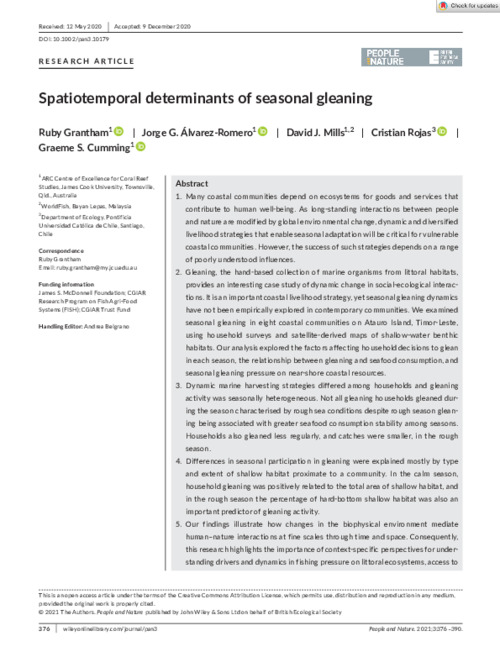Spatiotemporal determinants of seasonal gleaning

1. Many coastal communities depend on ecosystems for goods and services that contribute to human well-being. As long-standing interactions between people and nature are modified by global environmental change, dynamic and diversified livelihood strategies that enable seasonal adaptation will be critical for vulnerable coastal communities. However, the success of such strategies depends on a range of poorly understood influences.
2. Gleaning, the hand-based collection of marine organisms from littoral habitats, provides an interesting case study of dynamic change in social-ecological interactions. It is an important coastal livelihood strategy, yet seasonal gleaning dynamics have not been empirically explored in contemporary communities. We examined seasonal gleaning in eight coastal communities on Atauro Island, Timor-Leste, using household surveys and satellite-derived maps of shallow-water benthic habitats. Our analysis explored the factors affecting household decisions to glean in each season, the relationship between gleaning and seafood consumption, and seasonal gleaning pressure on near-shore coastal resources.
3. Dynamic marine harvesting strategies differed among households and gleaning activity was seasonally heterogeneous. Not all gleaning households gleaned during the season characterised by rough sea conditions despite rough season gleaning being associated with greater seafood consumption stability among seasons. Households also gleaned less regularly, and catches were smaller, in the rough season.
4. Differences in seasonal participation in gleaning were explained mostly by type and extent of shallow habitat proximate to a community. In the calm season, household gleaning was positively related to the total area of shallow habitat, and in the rough season the percentage of hard-bottom shallow habitat was also an important predictor of gleaning activity.
5. Our findings illustrate how changes in the biophysical environment mediate human–nature interactions at fine scales through time and space. Consequently, this research highlights the importance of context-specific perspectives for understanding drivers and dynamics in fishing pressure on littoral ecosystems, access to ecosystem benefits and limits to adaptation. Factors influencing when livelihood activities are feasible and desirable are important for evaluating the social impacts of climate change, particularly in the context of rural communities in the Global South.
Permalink
Date Available
Type
Publisher
Countries
ISSN
2575-8314
Copyright
CC-BY-4.0
Research Themes
Language